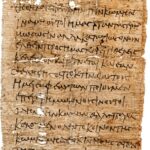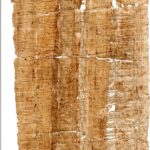| Artefact ID | 537 |
| TM ID | TM 33570 |
| Findspot (DEChriM ID) | 55 (Qarāra) | Class | Textual |
| Material | Papyrus |
| Writing medium | Sheet/roll |
| Text content | Documentary |
| Language | Greek |
| Archive/Dossier | Archive |
| Description | P.Neph. 19: Letter from the inhabitants of Nesoi to Paulos. Perfectly preserved letter sent by the community of the villagers of Nesoi to "the most revered father Paulos". The interpretation of the letter remains uncertain but it is clear that something has happened in the village of Nesoi, which gives the inhabitants a reason to suspect that a certain Paulos might complain about it to the authorities. Such a complaint would have devastating consequences for the villagers, including the destruction of their home. The village community therefore implores Paulos not to bring this matter before the authorities: Instead, he should appear in person in the village and present his wishes. These are to be obeyed, even if Paulos demands the murder of the culprits. The context of the event (see also P.Neph. 20), the identity of Paulos and the link with the archive of Nepheros remain unclear, but as there is no address on the back of the letter, it is not impossible that the letter was actually a copy kept by Nepheros and that Paulos was a member of the monastic community. Recto: upright cursive; writing runs along the fibres. |
| Selection criteria | Mention of Christian cult officials/institutions, Christian onomastics |
| Date from | 350 |
| Date to | 399 |
| Dating criteria | Palaeography, archive connection and historic context led the editors to suggest a range of date around 360 for the Nepheros correspondence (Kramer and Shelton 1987: 5). According to the study of the prices mentioned in the archive, Bagnall 1989: 75 (= BL IX, 173) suggests a range after 352. |
| Absolute/relative date | Relative date |
| Archaeological context | The P.Neph. were bought on the market but according to the seller they were all found together. Nothing in the archive led the editors to doubt this statement and they add that the archive were probably found in the direct vicinity of the ancient location of the monastery of Phathor (see Kramer and Shelton 1987: 5). |
| Accession number | Trier, University Library, P. UB Trier S 073-15 |


 Json data
Json data





